#the silk roads
Text
The Return Flight Home
In 2020, I had intended to travel overseas and revisit the United Kingdom in order to see the sights and sounds I’d missed on my first trip. COVID-19 prevented that from happening. It was only after three years of isolation and staying within the borders of Australia that I finally ventured onto a plane to take me away from the familiar. But instead of reinstating my original travel plans, I went one step further and joined a tour headed to Turkey and Egypt. Accompanying my grandmother, of all people.
And what an adventure it was!
True, it might not have been the one I had been hoping for but it was certainly something to experience, given my interest in Ancient History and love for mythologies that date back several millennia.
Although, as it soon came to pass, many places throughout Egypt and Turkey didn’t feel like I was enjoying their own cultural history so much as also getting a dose on Ancient Greece and Ancient Rome as well. That isn’t to say it’s a bad thing. Far from it! It shows how interconnected the ancient world was with trade ad culture. On the downside, it did dampen a little of my enthusiasm to realise that many of sites we visited weren’t exactly built by the local populace but rather the remnants of another civilisation that had dominated the area in ages past.
I suppose, though, that it goes to show the complex and interconnected nature of world history. After all, no nation can truly rise and fall in isolation. History has shown us time and again how greed and the entrepreneurial spirit of humans has led to new discoveries and the subsequent shrinking of the world.
That said, on the day of our flight back to Sydney, we made one last pit stop at the Suleymaniye Mosque as the Blue Mosque was still under renovations and not open for visitors. Smaller, it seemed than the Hagia Sophia, the Suleymaniye Mosque was decorated with a rich red carpet underfoot (that didn’t stink too much of unwashed feet) and had the usual trappings that I’ve come to associate with Baroque style mosques.
Built in 1557, it took about seven years for completion. Inside its walls, it contained medreses (a type of educational institution), a hospital, a hospice and Turkish baths to name but a few of the amenities.


For us tourists, it served as simple shelter from the drizzle that had hounded us since waking that morning. The rain, it should be known, followed us throughout the entire day with a vengeance. Even when we had finished looking at the mosque and headed to a retail outlet centre, the rain followed. All up until the time we headed to the airport for our flight back to Sydney.
As for the shopping centre, there wasn’t much difference to what we might see in Australia. What caught my eye as I wandered through the food court of the megaplex, though, was the fact that it had a Shake Shack! Of all things!
We don’t even have a Shake Shack in Australia yet! So, how come Turkey has one of the most popular East Coast burger chains and Australia doesn’t? It’s completely outrageous and I demand that a Shake Shack or an In-N-Out be properly established in Sydney.
They even have a Popeyes (although Google tells me that there is one in Melbourne)!
Other than the food court, I also saw shops that could be found in Australia as well as a few international brands. There was even a bookstore, the first I’d seen while overseas. Granted, it wasn’t just a bookstore but it had books as well as video games on display. For the first time in twenty or so days, I got a taste of actual normalcy!
I also caught sight of a spiffing leather jacket. Red, like the blood that would flow from when I’ve decapitated my enemies, and it was rocking a detachable hood. Sure, it cost 5000 Turkish lira, and was a little on a the expensive side. But you know what? I bought that sucker because it was screaming my name. And yes, it was a bit tight around my girth but I can always wear it unzipped...
Besides, they also say that leather stretches! And I was wearing multiple layers before trying it on.
Which, I know, sounds like excuses considering that it was XL but I’ll be the first to readily admit that I am on the overweight side of things. But only just a little! And...you know, that my face is too round. Which is why I hate photos and why it’s been tough on the dating scene as I have a minimal amount of photos that star me in them. Also, posing is an issue. How ought one stand? What should these upper appendages called arms be doing? Is it still acceptable for me to be doing the classic ‘v’ sign or is that too stereotypical of every Asian ever?
Gah! I’m having a meltdown over photographs!
What was I writing about?
Ah, yes, the last day in Turkey. Well, after downing a burger from Shake Shack - which, honestly, was my favourite meal during my entire trip - it wasn’t long before we waved a fond farewell to Turkiye. On the drive to the airport, we parted with the remaining lira we had, tipping the driver and the tour guide, Abdullah, for their services.
And then, it was a short-ish flight to Dubai before we were on our way back to Sydney (wherein I managed to sneak in Woman King and HBO’s adaption of the Time Traveler’s Wife starring Rose Leslie).
Overall, I must say, that the trip was one that I’ll remember fondly. While it had its ups and downs, I still learned a lot and got to see more of the wider world than if I’d still been too afraid to leave Australia. Books and movies and documentaries can bring the world to me but there is something about actually going out there and seeing things for myself that makes travelling so eye-opening and special. A picture might say a thousand words, but they’re almost always especially curated to evoke a feeling. Actually walking beside remnants of the past, interacting with the locals and trying their food is an entirely different experience. And one I hope to continue to experience now that the rest of the world is back on the menu.
COVID-19 might not be gone (and it might never be gone) but that shouldn’t stop people from living their best lives and seeing what the world has to offer. True, there might be limitations based on a person’s socioeconomic status and the physical capabilities, but for those that can, it’s something that can change you.
The world may be small in the grand scheme of things, but it’s also so much bigger than just a pretty blue bauble hanging in the heavens. There is a rich history here that is begging to be uncovered to its fullest extent. And from what I’ve learned from travelling, as well as reading a history book as I travelled, the progression of the human race as a whole is all about engaging with their culture, beliefs and way of life rather than crushing it all under an imperialist heel or the misguided attempts of defending one’s interests.
We can all learn from being a little bit more open-minded and tolerant of the ideas of others rather than falling back into a tribal mentality of us versus them. As history has shown, it never works well and it’s all fuelled by self-interest. Open dialogue is the real path forward to success. Here’s hoping people can see that before they allow themselves to blindly trot down the path of mutual destruction.
Now, to end it all with inexplicable photos of animals. Mostly cats. Why? Because both Turkey and Egypt had way too many feral animals on the prowl. So, while they may appear cute, do not approach! You can, however, take quality photos of them from a distance.
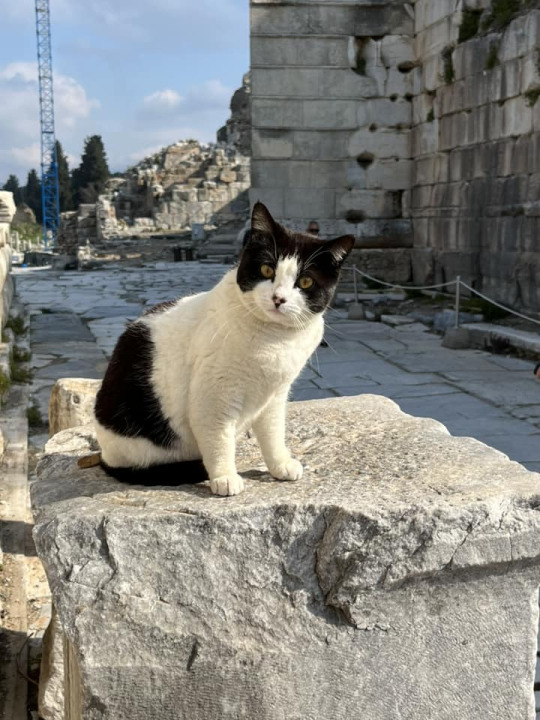
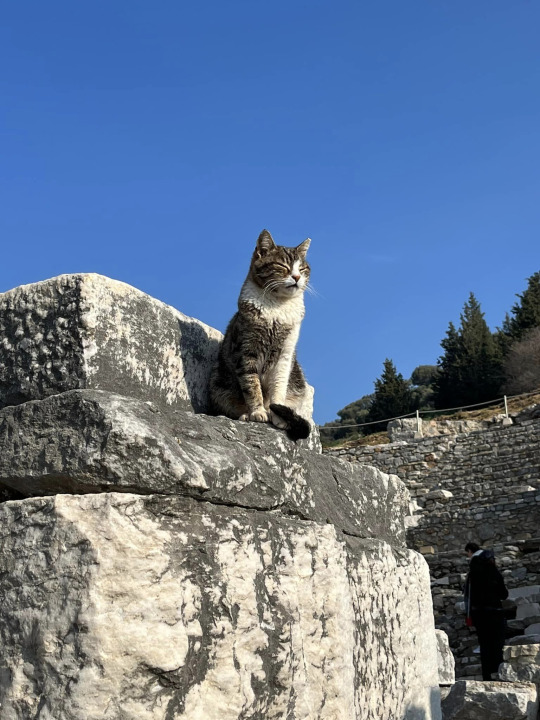


3 notes
·
View notes
Text

I'd like to think that we ruled the world for a short moment in time.
femslash february day 1: POWER
#hetalia#indchu#nyo india#nyo china#femtalia24#yes I am ONE WEEK LATE to DAY 1 of femtalia#I’m so embarrassed I am never promising anything again I am a fool I'm so sorry#but indchu…. god they’re amazing…. literally crying as I go thru their history#the real Silk Road pair don’t @ me#kikidoodlez
283 notes
·
View notes
Text

Uyghur bread, Xinjiang China.
862 notes
·
View notes
Text




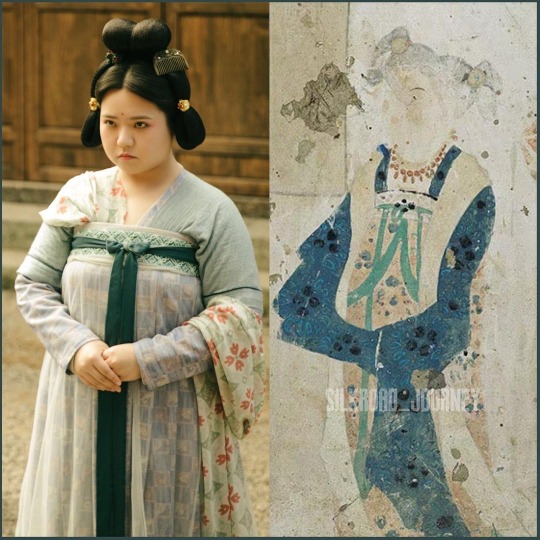

Tang dynasty period drama (Luoyang 风起洛阳) 2021
Vast majority of the C-drama costumes are restored based on real Tang dynasty paintings from the Mogao Caves. These are some examples.
Photos credit: silkroad_journey on Instagram.
#chinese history#chinese culture#hanfu#tang dynasty#Buddhism#mogao caves#China#silk road#ancient china#Medieval China#chinese drama#cdrama#hanfu recreation#Hanfu restoration#dynastic china#art
225 notes
·
View notes
Text
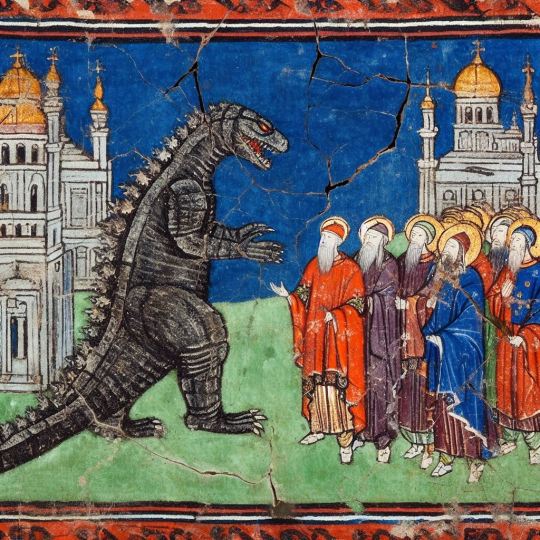
Godzilla was chosen by Byzantine emperor Andronikos II Palaiologos to meet the first Chinese delegation sent to Europe in the 14th century.
118 notes
·
View notes
Photo

Gregor Sailer / The Polar Silk Road / Photography / 2020
234 notes
·
View notes
Text
On the crest of a hill, the third voice enters: a voice that demonstrates, with elegant precision, the primacy of speech over writing. Johann Drake is trying to swallow a Bible. Take it, and eat it up. Eating a book is a nonliterate response to text. Ingested and digested, the words become part of the speaker, who is then endowed with the spirit of prophecy. The image echoes the sacrament of communion, in which participants ingest the body of Christ, the Word made flesh. The vision of eating a book evokes a transcendent relationship with language, in which one is not a speaker but an instrument. The words of the Book flow from one’s mouth. Pure praise, pure expression, like lark song. As the old hymn puts it, “How can I keep from singing?”
—Sofia Samatar, The White Mosque: A Memoir
70 notes
·
View notes
Note
there was Chinese interest in the Out Of Asia theory, in both the Republic, Chiang Republic and People’s Republic periods before the Out Of Africa theory became commonly accepted. Was the 1954 Yeti expedition done just from the Nepalese-Indian side or were the American agents and “anthropologists” given access on the Sino-Tibetan side of the Himalayan border?
During the early part of this century, it was absolutely believed for a long time that the deserts of Western China were the most likely place of human origins, as seen in this migration map from 1944, made from the best available knowledge of the time:
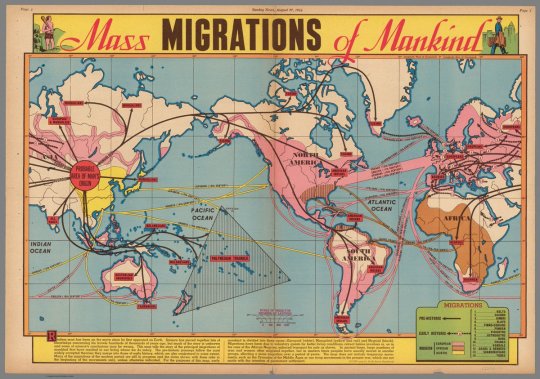
Remember, the oldest fossil remains at this point were in China, where Homo erectus was discovered (originally known by his initial place of discovery in Chungkotien Cave, nicknamed "Peking Man"). The discovery of Australopithecus and Homo habilis in Olduvai Gorge and South Africa, which place human origins in Africa, were not until the 50s and 60s, so it seemed entirely reasonable that Homo sapiens evolved in Western China.
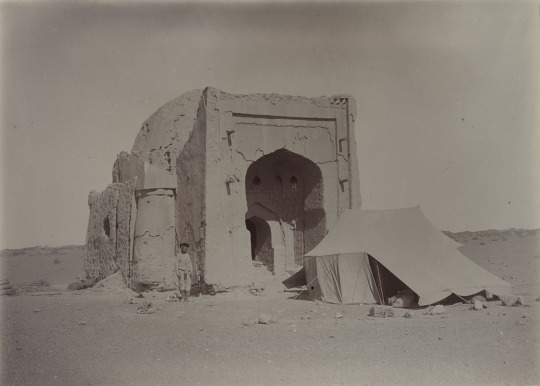
The idea that China's desert regions were the origin of modern humans and culture is seen a lot in pop culture from 1900-1950, mainly because there were tremendous explorations in the region, especially Aurel Stein's expedition of 1908, who ventured into the Taklamakan Desert to find the Dunhuang Caves and Khara-Khoto, a city destroyed completely by Genghis Khan and vanished in the desert.
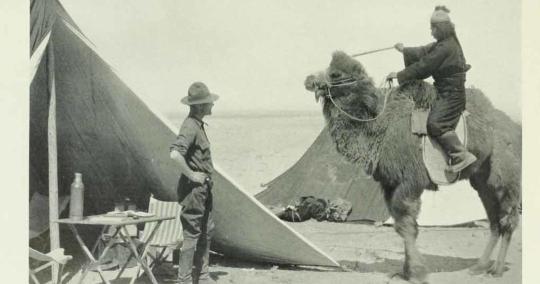
If you've ever heard of Roy Chapman Andrews and his famous expeditions in the 1920s, it's worth noting that he ventured into the Gobi Desert looking for human remains....not dinosaurs, and the discovery of dinosaur eggs was an unexpected surprise.
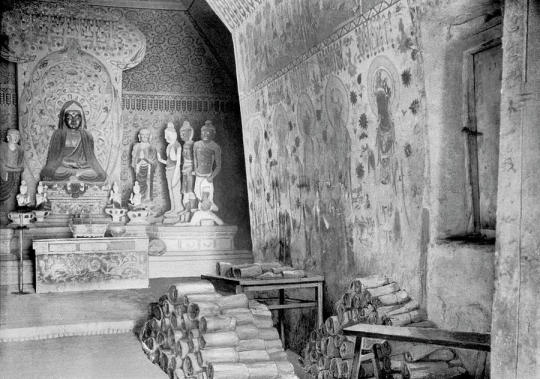
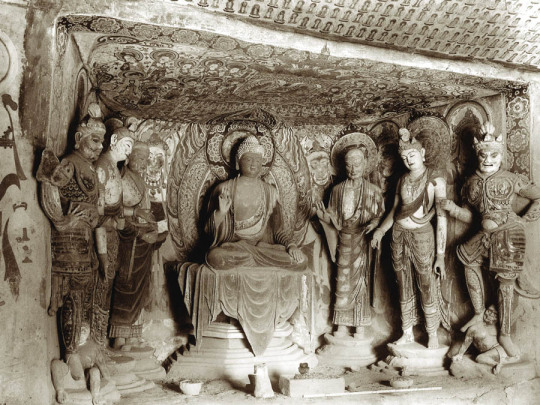
For that reason, there was a short lived Silk Road Mania that seemed to be a smaller scale predecessor to the pop culture dominating Egyptomania of the 1920s. It's bizarre to read adventure and fantasy fiction of the 1910s-1920s that features mentions of Silk Road peoples like the Kyrgyz, Sogdians, Tajik, Uigurians, and Tuvans. The best example I can think of would be the Khlit the Kossack stories of Harold Lamb (who also wrote a biography of Tamerlane), which together with Tarzan and Tros of Samothrace, formed the core inspiration for Robert E. Howard's Conan the Barbarian.
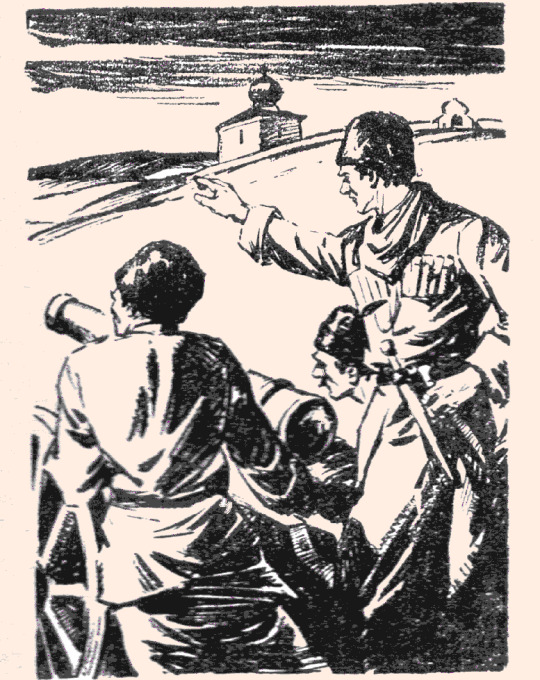
The most interesting example of this would be A. Merritt's Dwellers in the Mirage, which featured a lost city in Xinjiang that was the home of the Nordic race, who worshipped their original religion, the kraken-like squid devil god Khalkru. It was widely believed in this era that Nordics emerged from Central Asia originally, and while it's easy to write this off as turn of the century racialist claptrap pseudohistory (along with Hyperborea legends), in this case, it is actually true: a branch of the Indo-European family lived in West China, and 5,000 year old redheaded mummies have been found in the region. As usual, A. Merritt was right on the money with his archeology, more so than other 1920s authors. After all, his "Moon Pool" was set around the just discovered ruins of Nan Madol, the Venice of Micronesia.

Jack Williamson's still chilling Darker Than You Think in 1948 was also set in the Silk Road/Central Asian region, as the place the race of shapeshifters emerged from, Homo magi, who await the coming of their evil messiah, the Night King, who will give them power over the human race.
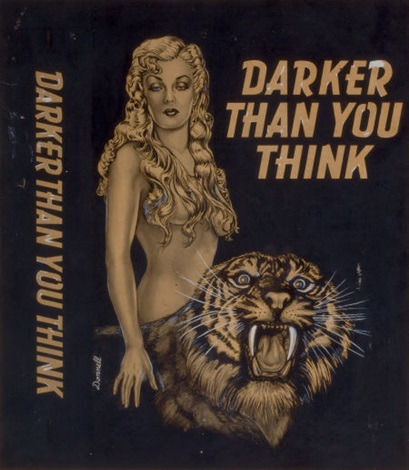
H. Rider Haggard set "Ayesha: the Return of She" (1905) in Xinjiang, among a lost Greek colony in Central Asia (no doubt based on Alexandria on the Indus, a Greek colony in modern Pakistan that was the furthest bastion of Greek Culture). This was also two years after the Younghusband Thibetan Expedition of 1903, where the British invaded Tibet. At the time, the Qing Dynasty was completely declining and lost control of the frontier regions, and the power vacuum was filled by religious authority by default (this is something you also saw in Xinjiang, where for example, the leader of the city was the Imam of Kashgar).
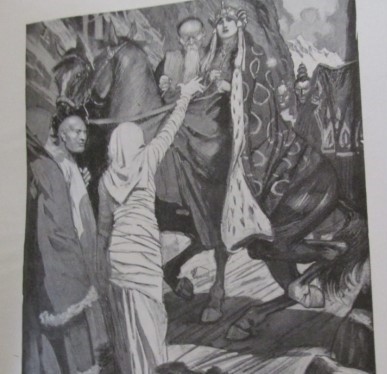
This is one of the many British invasions they have attempted to cram down the memory hole, but if you ever see a Himalayan art piece that was "obtained in 1903-1904" ....well, you know where it came from.
Incidentally, there's one really funny recent conspiracy theory about paleontology, fossils, and China that I find incredibly interesting: the idea that dinosaurs having feathers is a lie and a sinister plot spread by the Communist Chinese (who else?) to make American youth into sissy fancylads, like Jessie "the Body" Ventura. How? By lying to us and making up that the manly and vigorous Tyrannosaurus, a beast with off the charts heterosexuality and a model for boys everywhere, might have been feathered like a debutante's dress. What next - lipstick on a Great White Shark? The long term goal is to make Americans effeminate C. Nelson Reilly types unable to defend against invasion. This is a theory that is getting steam among the kind of people who used to read Soldier of Fortune magazine, and among abusive stepfathers the world over.

...okay, are you done laughing? Yeah, this is obvious crackpottery and transparent sexual pathology, on the level of the John Birch Society in the 60s saying the Beatles were a Communist mind control plot. Mostly because animals just look how they look, and if it turned out that the ferocious Tyrannosaurus had feathers and looked like a fancylad Jessie Ventura to you, well, that's your problem and mental baggage, really.
I was left scratching my head over this one. But there is (kind of) something to this, and that is that a huge chunk of recent dinosaur discoveries have been in China. I don't think it has anything to do with a Communist plot to turn American boys into fancylads, but more to do with a major push in internal public investment in sciences in that country, and an explosion of Chinese dinosaur discoveries. If you want to see a great undervisited dinosaur museum, go to the Zigong Dinosaur Museum in Sichuan.

Pop quiz: what living scientist has named more dinosaur discoveries? It's not Bakker or Horner. The greatest living paleontologist, Xu Xing, which is why a lot of recently found dinosaurs are named things like Shangtungasaurus.
241 notes
·
View notes
Text
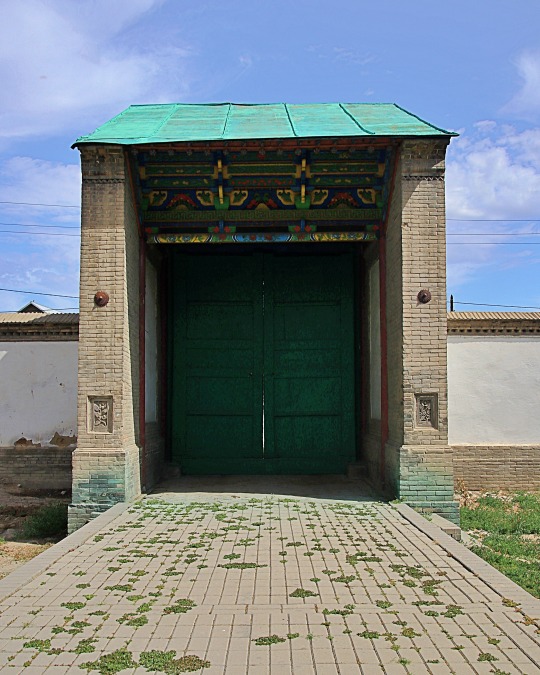
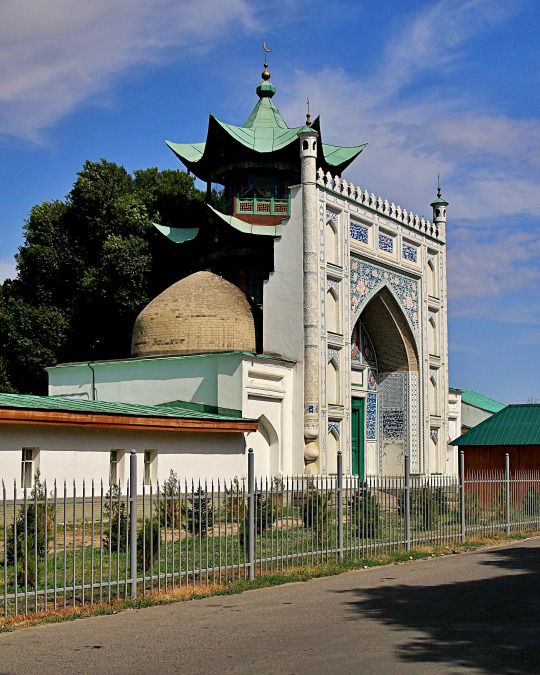
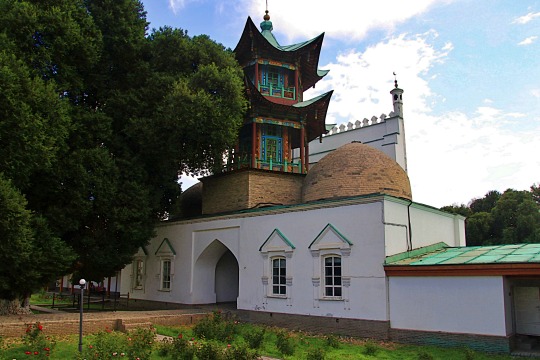
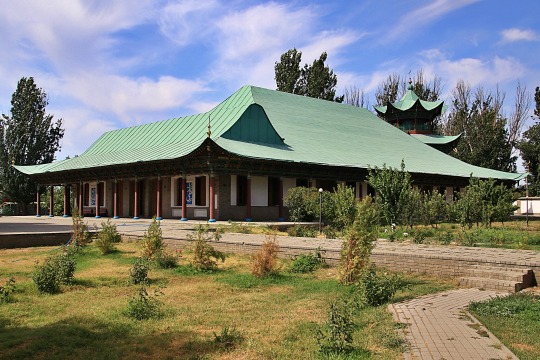
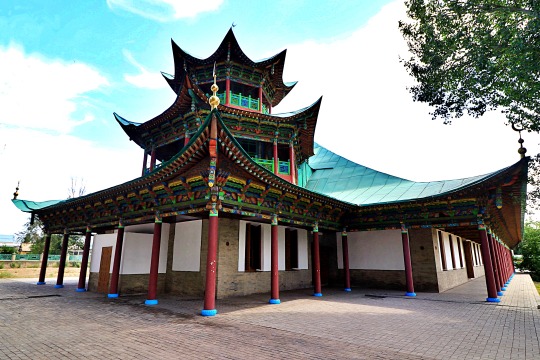

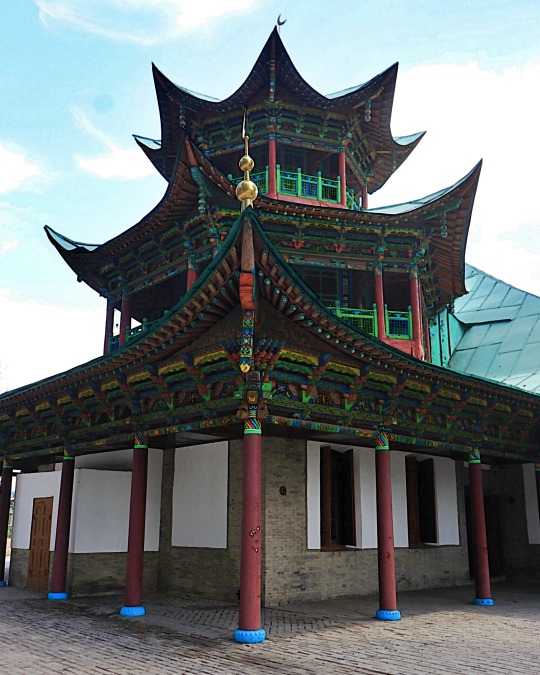
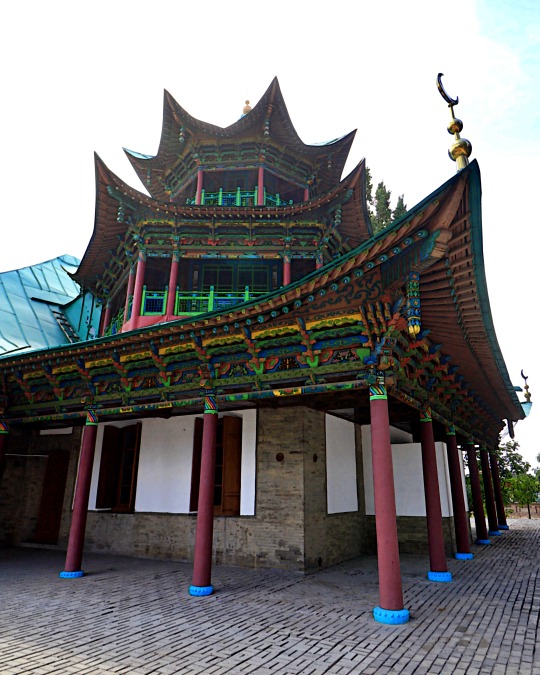

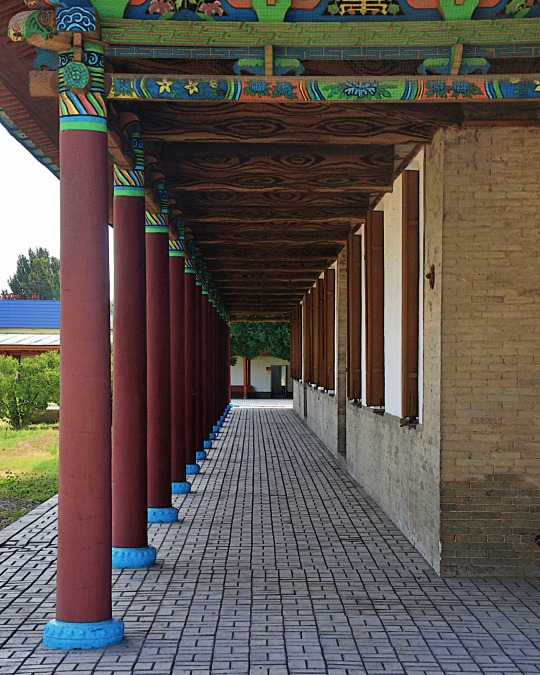
Old Mosque ( Zharkent / Kazakhstan )
#travel#travelphotography#photooftheday#adventure#trip#chinasestyle#kazakhstan#aroundtheworld#kazakhstantravel#mosque#islamic art#islamic architecture#zharkentoldmosque#zharkent#ualibaymosque#chineseislamicarchitecture#silk road#central asia#visitkazakhstan#oldmosque#architecture#islam
111 notes
·
View notes
Text
German linguists appear to have made an important breakthrough in cracking a previously unknown script, revealing it to be a Kushan language used by traders along the Silk Road.
#language#Silk Road#Tajikistan#script#Kushan#linguistics#decode#ancient#history#ancient origins#egypt
281 notes
·
View notes
Text

Female Europid Mummy from the Necropolis of Subexi III, Grave M6, Turfan District, Xinjiang. 5th-3rd C. BCE. Source: Baumer, Christoph.The history of Central Asia. Vol.1. The age of the steppe warriors. London : I.B. Tauris, 2012. pg. 218 left DS329.4 .B38 2012. Image via University of Pennsylvania. See maps in the post before this one for a better understanding of the geography discussed.
"Section 26 – The Kingdom of Nearer [i.e. Southern] Jushi 車師前 (Turfan)
1. ‘Nearer Jushi’ 車師前 refers to the kingdom or state centered in the Turfan oasis or, sometimes, to the tribe which controlled it. There can be no question that Nearer Jushi refers here to the Turfan Oasis. See for example: CICA, p. 183, n. 618; also note 1.5 above. For the etymology of the name Turfan see Bailey (1985), pp. 99-100, which is summed up in his sentence: “The name turpana- is then from *druva-pāna- ‘having safe protection’, a name suitable for a walled place.”
“One other oasis town is currently under excavation. At Yarghul (Jiaohe), 10 km (16 miles) [sic – this should read 10 miles (16 km)] west of Turpan, archaeologists have been excavating remains of the old Jushi capital, a long (1,700 m (5,580 ft)) but narrow (200 m (656 ft)) town between two rivers. From the Han period they uncovered vast collective shaft tombs (one was nearly 10 m (33 ft) deep). The bodies had apparently already been removed from these tombs but accompanying them were other pits containing form one to four horse sacrifices, with tens of horses for each of the larger burials.” Mallory and Mair (2000), pp. 165 and 167.
“Some 300 km (186 miles) to the west of Qumul [Hami] lie [mummy] sites in the vicinity of the Turpan oasis that have been assigned to the Ayding Lake (Aidinghu) culture. The lake itself occupies the lowest point in the Turpan region (at 156 m (512 ft) below sea level it is the lowest spot on earth after the Dead Sea). According to accounts of the historical period, this was later the territory of the Gushi, a people who ‘lived in tents, followed the grasses and waters, and had considerable knowledge of agriculture. They owned cattle, horses, camels, sheep and goats. They were proficient with bows and arrows.’ They were also noted for harassing travellers moving northwards along the Silk Road from Krorän, and the territories of the Gushi and the kingdom of Krorän were linked in the account of Zhang Qian, presumably because both were under the control of the Xiongnu. In the years around 60 BC, Gushi fell to the Chinese and was subsequently known as Jushi (a different transcription of the same name).” Mallory and Mair (2000), pp. 143-144.
“History records that in 108 BC Turpan was inhabited by farmers and traders of Indo-European stock who spoke a language belonging to the Tokharian group, an extinct Indo-Persian language [actually more closely related to Celtic languages]. Whoever occupied the oasis commanded the northern trade route and the rich caravans that passed through annually. During the Han Dynasty (206 BC-AD 220) control over the route see-sawed between Xiongnu and Han. Until the fifth century, the capital of this kingdom was Jiaohe.” Bonavia (1988), p. 131.
“Turpan is principally an agricultural oasis, famed for its grape products – seedless white raisins (which are exported internationally) and wines (mostly sweet). It is some 80 metres (260 feet) below sea level, and nearby Aiding Lake, at 154 metres (505 feet) below sea level, is the lowest continental point in the world.” Ibid. p. 137.
“The toponym Turfan is also a variation of Tuharan. Along the routes of Eurasia there are many other place names recorded in various Chinese forms that are actually variations of Tuharan.” Liu (2001), p. 268."
-Notes to The Western Regions according to the Hou Hanshu. Second Edition (Extensively Revised and Expanded). John E. Hill. University of Washington.
#tocharian#celtic#indo european#tarim basin#xinjiang#chinese history#mummies#history#ancient history#archaeology#anthropology#silk road#pagan
458 notes
·
View notes
Photo

The Silk Road between The Roman Empire and the Han Dynasty,1st-3rd century.
128 notes
·
View notes
Text

Camping on the largest and maybe windiest of the Silk Cayes.
Belize
1992
#vintage camping#campfire light#belize#silk cayes#gladden spit#camping#road trips#travel#exploring#history
150 notes
·
View notes
Text
Chemistry Behind Ancient Pigment, 'Chinese Purple'

In ancient times, rare non-natural pigments, especially blues and purples. 'Chinese Purple' or 'Han Purple' a Barium Copper Silicate BaCuSi₂O₆ pigment, emerged from the Western Zhou to the Han Dynasty, found in terracotta army garments at the Qin Shi Huang Mausoleum. Initially linked to Egyptian Blue, Chinese Purple predates Silk Road contacts by centuries, suggesting an independent discovery.
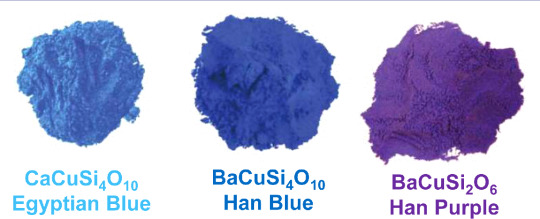
Likely an alchemical serendipity during Daoist experiments, its compounds—copper, barium, and lead—aligned with materials used by Daoist alchemists in creating ancient lead-barium glass.
#purple#ancient history#pigment#ancient china#chemistry#ancient culture#terracotta#silk road#interesting stuff#amazing facts#history
64 notes
·
View notes
Text

Silvia Furmanovich Silk Road Bracelet
Photo Courtesy: Silvia Furmanovich
Source: townandcountrymag.com
#silvia furmanovich#silk road#high jewelry bracelet#high jewelry#luxury jewelry#fine jewelry#fine jewellery pieces#gemville
78 notes
·
View notes
Text

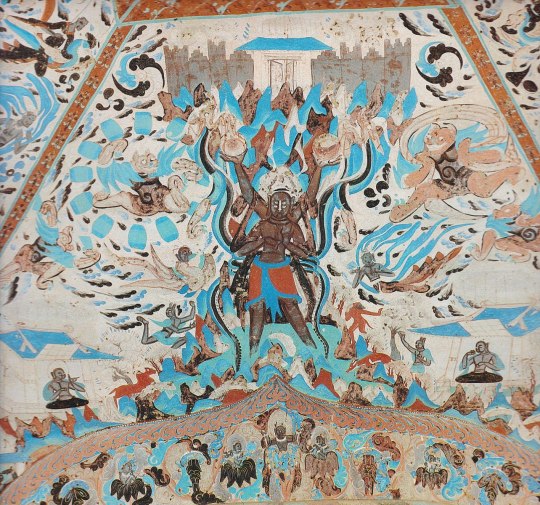
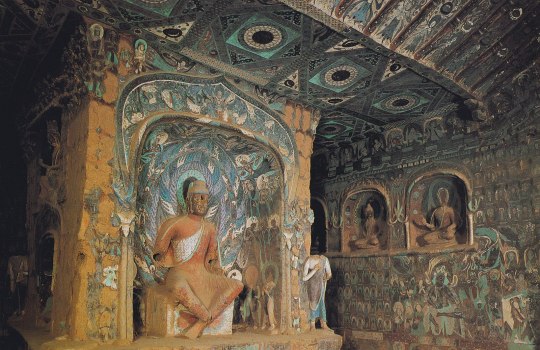

Much of the art in the medieval Buddhist temple-caves at Dunhuang was meant to inspire monks in their meditation. This is the art that is truly spectacular. It’s meant to be mind-blowing, to obliterate monks’ egos and help them to attain nirvana — literally, the blowing out of the flame of desire.
Artists created swirling, complex tableaux of people, animals, and supernatural figures. This was known as the "thousand-Buddha" style -- every square inch of the caves was covered with religious art.
{WHF} {Ko-Fi} {Medium}
195 notes
·
View notes